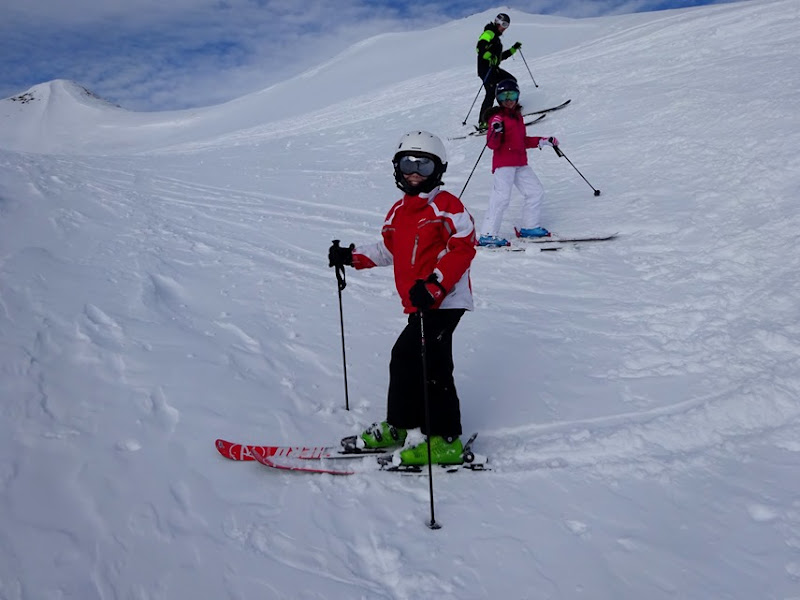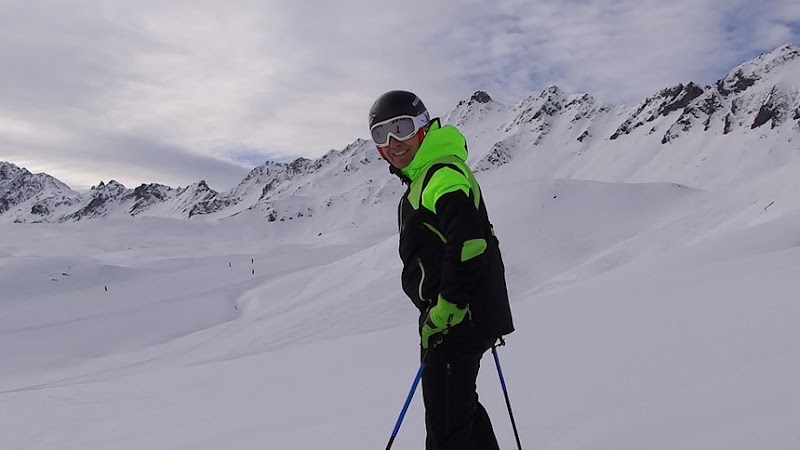Last day and Daisy was back with us. Despite Daisy missing out on the consistent training needed to build her confidence and technique at this stage (Each day adds a big chunk of experience!) she had a very positive attitude and was really keen to get into the slalom course. Knowing that two years ago she hurt her wrist very badly in the slalom I was maintaining silence on the subject myself – and the motivation came entirely from Daisy herself. Following the slalom we went on a proper off-piste excursion with deep and tricky snow – affected by yesterday’s late temperature rise – and Daisy wasn’t in the least bit worried about that either. Alex had been great all week too – accepting that he wouldn’t be able to do the jumping that he had obviously been looking forward to (there was no airbag jump set up) and just adapted to make the most of any other opportunities. Despite Alex’s obvious improvement in technique this didn’t translate into a faster time in the slalom for him. Had the slalom timing equipment been working though I’m sure it would have brought a result as his line through the course would have quickly improved – but we stopped slalom thinking he already had a faster time – which at between 29.7 and 30 seconds was still in the “bronze”.
Alex Technique
Alex’s first run in the slalom course was a mess because he just thought about beating his previous time and not about the recent changes he has been applying to his skiing. He was then asked to have another run through the course and this time to think about pulling back his hip and increasing his dynamic range. This time he made the changes and his skiing and grip were vastly improved . It would have taken a few runs to translate this into a better time because with the new feelings involved the skis would take a different line and practically everything would change. Unfortunately an electrical fault in the slalom timing circuit caused us to be wasting too much time and to have no direct feedback – so it was time to move on to the off-piste. Off piste in deep snow Alex actually did very well – but once again he was pitched over to the outside when the terrain surprised him. The answer to this issue is exactly the same as for slalom – get the body to the inside of the turn and work to prevent hip rotation. Towards the end of the session we practiced pivoting on either ski or both skis (close stance – acting as a single platform) and Alex can now manage all permutations.
Daisy Technique
Daisy, when confronted with anything slightly challenging, has developed the habits of leaning back against her ski boots and using the inside ski as a stabiliser. Once we had finished with the slalom and off piste we spent some time working on “stance” to help to change this situation. Daisy was asked to lean against the backs of the boots while standing still on flat ground – to feel the muscles tighten in the fronts of the legs. she was then asked to lean against the fronts of the boots and to feel the muscle tension in the backs of the legs. After this she was asked to stand in the middle and not lean against the boots to feel how relaxed it is. The point is that when sliding downhill this should be the “basic stance” – with the skier perpendicular to the slope (explained visually using ski poles). We practiced running straight downhill on a gentle to moderate undulating slope so that Daisy could have the opportunity to feel how to make the appropriate adjustments. On her next run we practiced pivoting – mainly to allow her to feel the ease of the pivot on on leg when an improved stance is adopted. Pivoting just won’t happen when locked in the back of the boots. Daisy had improved, narrowing her stance naturally in just the very short window of time that she had my full attention. 
Mike Technique
Mike was really starting to overcome the “Zag effect” – were the extra ski width and aggressive parabolic sidecut of the ski had initially brought out all the worst gremlins in his skiing. During the off piste descent Alex was sure that his dad was going to face plant – but I was pretty sure that he wasn’t. Mike used his dynamics but still respecting the need to pivot – keeping the feet downhill from the body and relatively close together (to hopefully act as a single platform). The main limitation here was just lack of experience but the skis worked fine and there was a flotation effect. The legs needed to be used independently but simultaneously to create one platform when pivoting is being used in deep snow. This is one of the reasons why we spent a moment later on revising the “two ski” pivot. 
